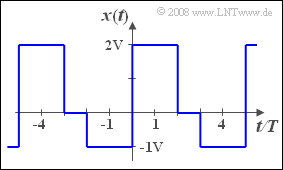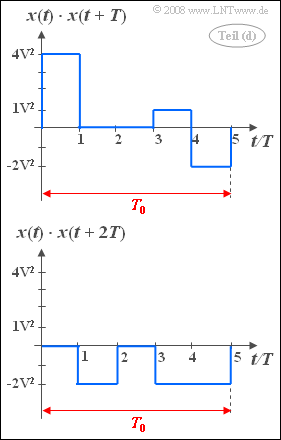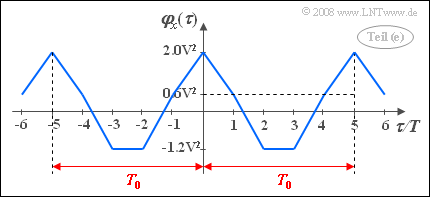Difference between revisions of "Aufgaben:Exercise 4.09Z: Periodic ACF"
| Line 84: | Line 84: | ||
'''(5)''' An auto-correlation function is always even: $\varphi_x (-\tau)= \varphi_x (\tau)$. | '''(5)''' An auto-correlation function is always even: $\varphi_x (-\tau)= \varphi_x (\tau)$. | ||
*In addition, for periodic processes, the ACF is also periodic with the same periodic time $T_0$ as the individual pattern functions. It follows that: | *In addition, for periodic processes, the ACF is also periodic with the same periodic time $T_0$ as the individual pattern functions. It follows that: | ||
| − | [[File:P_ID383__Sto_Z_4_9_e.png|right|frame| | + | [[File:P_ID383__Sto_Z_4_9_e.png|right|frame|Wanted auto-correlation function]] |
:$$\varphi_x ( 0) = \varphi_x (5 T) = \varphi_x (10 T) = \ \text{...} \ = \it P_x = \rm 2 \,V^2,$$ | :$$\varphi_x ( 0) = \varphi_x (5 T) = \varphi_x (10 T) = \ \text{...} \ = \it P_x = \rm 2 \,V^2,$$ | ||
Revision as of 18:32, 28 February 2022
We consider in this exercise a periodic and simultaneously ergodic stochastic process $\{x_i(t)\}$, which is fully characterized by the presented pattern function $x(t)$ .
Further pattern signals of the random process $\{x_i(t)\}$ are obtained by shifting by delays of different sizes $\tau_i$, where $\tau_i$ is assumed to be uniformly distributed between $0$ and the period $T_0$ .
Hint:
- The exercise belongs to the chapter Auto-Correlation Function.
Questions
Solution
(1) The (normalized) period duration is $T_0/T \hspace{0.15cm}\underline{= 5}.$
(2) Due to periodicity, the averaging üg over a periodic time $T_0$:
- $$m_x = \frac{1}{T_0} \cdot \int_0^{T_0} x(t) \hspace{0.1cm}{\rm d} t = \frac{1}{5 T} \cdot (2\hspace{0.05cm}{\rm V} \cdot 2 T - 2\hspace{0.05cm}{\rm V} \cdot 2 T) \hspace{0.15cm}\underline{= \rm 0.4 \,V}.$$
(3) In analogy to the last sub-task, we obtain for the mean power:
- $$P_x = \frac{2 T}{5 T} \cdot \big[(\rm 2V)^2 +(- \rm 1V)^2 \big]\hspace{0.15cm}\underline{ = \rm 2 \,V^2}.$$
(4) The accompanying graph shows in each case in the range from $0$ to $T_0 = 5T$.
- above the product $x(t) \cdot x(t+T)$,
- down the product $x(t) \cdot x(t+2T)$.
Note that $x(t+T)$ means a shift of the signal $x(t)$ by $T$ to the left.
From these sketches follow the relations:
- $$\varphi_x (T)= \rm {1}/{5 } \cdot (\rm 4V^2 + \rm 1V^2 - \rm 2V^2) \hspace{0.15cm}\underline{= \rm 0.6\, V^2},$$
- $$\varphi_x ( 2 T)= \rm {1}/{5 } \cdot(-\rm 2V^2 \cdot 3) \hspace{0.15cm}\underline{= - \rm 1.2 \,V^2}.$$
(5) An auto-correlation function is always even: $\varphi_x (-\tau)= \varphi_x (\tau)$.
- In addition, for periodic processes, the ACF is also periodic with the same periodic time $T_0$ as the individual pattern functions. It follows that:
- $$\varphi_x ( 0) = \varphi_x (5 T) = \varphi_x (10 T) = \ \text{...} \ = \it P_x = \rm 2 \,V^2,$$
- $$\varphi_x (3 T) = \varphi_x (-3 T) =\varphi_x (2 T) = \ \text{...} \ \hspace{0.15cm}\underline{= - \rm 1.2 \,V^2},$$
- $$\varphi_x (4 T) = \varphi_x (-4 T) =\varphi_x ( T) = \ \text{...} \ \hspace{0.15cm}\underline{= \rm 0.6 \,V^2}.$$
- The calculated ACF values can be connected by straight line sections, since integration üover rectangular functions always yields linear subsections.
(6) The five intervals $(0$ to $T)$, $(T$ to $2T)$, ... , $(4T$ to $5T)$ provide the contributions.
- $$(+1.3; -0.3; -1.2; -0.3; +1.3) \cdot \rm V^2.$$
- This gives the expected value (linear mean):
- $${\rm E}\big[\varphi_x(\tau)\big] = 1/5 \cdot (1.3-0.3 -1.2 -0.3 +1.3]\hspace{0.15cm}\underline{= \rm 0.16 \,V^2}.$$
- This corresponds to the square of the mean $m_x$ ⇒ see subtask (2).


